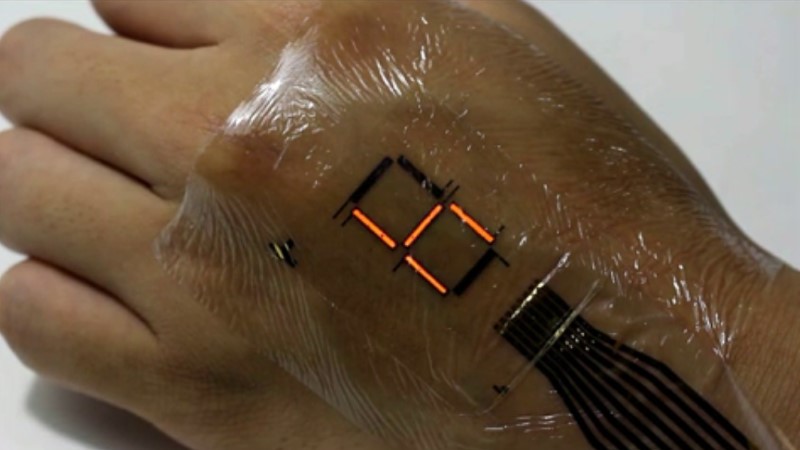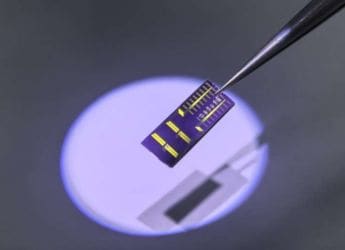- Home
- Science
- Science News
- Ultrathin Organic Material to Help Make Better E Skin Displays: Study
Ultrathin Organic Material to Help Make Better E-Skin Displays: Study

The technology will enable the production of ultrathin, ultraflexible, high performance wearable electronic displays and other devices, researchers said.
Integrating electronic devices with the human body to enhance or restore body function for biomedical applications is the goal of researchers around the world.
In particular, wearable electronics need to be thin and flexible to minimise impact where they attach to the body.
However, most devices developed so far have required millimetre-scale thickness glass or plastic substrates with limited flexibility, while micrometre-scale thin flexible organic devices have not been stable enough to survive in air.
The researchers at the University of Tokyo have developed an ultrathin, ultraflexible, protective layer and demonstrated its use by creating an air-stable, organic light-emitting diode (OLED) display.
The group developed the protective film by alternating layers of inorganic (Silicon Oxynitrite) and organic (Parylene) material.
The protective film prevented passage of oxygen and water vapour in the air, extending device lifetimes from the few hours seen in prior research to several days.
The researchers attached transparent indium tin oxide (ITO) electrodes to an ultrathin substrate without damaging it, making the e-skin display possible.
Using the new protective layer and ITO electrodes, the research group created polymer light-emitting diodes (PLEDs) and organic photodetectors (OPDs).
These were thin enough to be attached to the skin and flexible enough to distort and crumple in response to body movement.
The PLEDs were just three micrometres thick and over six times more efficient than previously reported ultrathin PLEDs.
This reduces heat generation and power consumption, making them particularly suitable for direct attachment to the body for medical applications such as displays for blood oxygen concentration or pulse rate.
The research group also combined red and green PLEDs with a photodetector to demonstrate a blood oxygen sensor.
"The advent of mobile phones has changed the way we communicate. While these communication tools are getting smaller and smaller, they are still discrete devices that we have to carry with us," said Takao Someya, professor at University of Tokyo.
"What would the world be like if we had displays that could adhere to our bodies and even show our emotions or level of stress or unease?" Someya asked.
"In addition to not having to carry a device with us at all times, they might enhance the way we interact with those around us or add a whole new dimension to how we communicate," he said.
Get your daily dose of tech news, reviews, and insights, in under 80 characters on Gadgets 360 Turbo. Connect with fellow tech lovers on our Forum. Follow us on X, Facebook, WhatsApp, Threads and Google News for instant updates. Catch all the action on our YouTube channel.
Related Stories
- Samsung Galaxy Unpacked 2025
- ChatGPT
- Redmi Note 14 Pro+
- iPhone 16
- Apple Vision Pro
- Oneplus 12
- OnePlus Nord CE 3 Lite 5G
- iPhone 13
- Xiaomi 14 Pro
- Oppo Find N3
- Tecno Spark Go (2023)
- Realme V30
- Best Phones Under 25000
- Samsung Galaxy S24 Series
- Cryptocurrency
- iQoo 12
- Samsung Galaxy S24 Ultra
- Giottus
- Samsung Galaxy Z Flip 5
- Apple 'Scary Fast'
- Housefull 5
- GoPro Hero 12 Black Review
- Invincible Season 2
- JioGlass
- HD Ready TV
- Laptop Under 50000
- Smartwatch Under 10000
- Latest Mobile Phones
- Compare Phones
- OnePlus 15R
- Realme Narzo 90x 5G
- Realme Narzo 90 5G
- Vivo S50 Pro Mini
- Vivo S50
- OPPO Reno 15c
- Redmi Note 15 5G
- Redmi Note 15 Pro 5G
- Asus ProArt P16
- MacBook Pro 14-inch (M5, 2025)
- Infinix Xpad Edge
- OnePlus Pad Go 2
- OnePlus Watch Lite
- Just Corseca Skywatch Pro
- Acerpure Nitro Z Series 100-inch QLED TV
- Samsung 43 Inch LED Ultra HD (4K) Smart TV (UA43UE81AFULXL)
- Asus ROG Ally
- Nintendo Switch Lite
- Haier 1.6 Ton 5 Star Inverter Split AC (HSU19G-MZAID5BN-INV)
- Haier 1.6 Ton 5 Star Inverter Split AC (HSU19G-MZAIM5BN-INV)

















